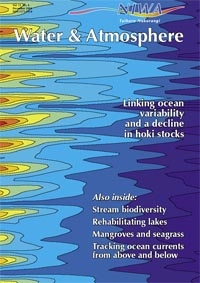
On this page
- Tsunami: the great waves – knowledge is safety
- Fuelling science by young people
- NIWA hosts meeting of infrared experts from NDSC
- Winston Churchill Fellowship
- End of a trap
- New quick guides simplify identification of freshwater flora and fauna
- Focus on corallines
- Recent publications by NIWA staff
Tsunami: the great waves – knowledge is safety
Tsunami is one of New Zealand’s underrated natural hazards. The last major event was caused by a massive earthquake in Chile in May 1960. Consequently, the nation now has a younger generation with little appreciation of the danger tsunami pose to coastal communities and what to do in response to warnings.
November saw the launch of New Zealand’s first interactive tsunami learning centre, at the National Aquarium of New Zealand in Napier. It has been developed on the initiative of Hawke’s Bay Civil Defence officers to inform local people and visitors to the area of the tsunami risk. The display’s Napier location is apt, as the east coast of New Zealand is particularly vulnerable to tsunami (from local and distant Pacific sources). Earthquakes offshore of Hawke’s Bay and Gisborne have triggered damaging tsunami in the past.
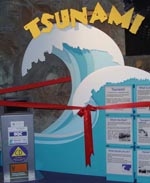
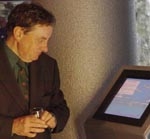
The interactive tsunami display was opened by George Hawkins, Minister of Civil Defence & Emergency Management.
A kiosk features animations that show how tsunami start after earthquakes or undersea landslides and then travel into the coast. A touch screen takes viewers into different levels of information showing maps, diagrams, and photographs. Historical information on the known tsunami around New Zealand shows the real damage and casualties. Included in the display are the testimonies of survivors of a tsunami in 1947 and the 1960 event, which damaged property on the shoreline in Napier and Gisborne.
The display’s key purpose is to alert people to what actions they should take when near the coast. They need to find out their local warning for tsunami and have a planned escape route to get to safety.
The basic rule is to move away from the coast 1 km or go uphill 35 m, staying away from rivers and streams (as wave surges can travel up these). The speed at which tsunami waves approach the coast and travel up over the land means that they can’t be outrun, so you need to get away from high hazard areas as quickly as possible.
The learning centre was coordinated by Hawke’s Bay Regional Council with expertise from NIWA and the Institute of Geological and Nuclear Sciences (GNS), interactive kiosk development by George Payne (NIWA), and advice and support from the Earthquake Commission and the Ministry of Civil Defence & Emergency Management.
We hope that similar tsunami learning centres can be set up in other regions.
For further information on the tsunami kiosk, contact: Rob Bell or George Payne, NIWA, PO Box 11115, Hamilton (ph +64 7 856 7026, [email protected])
Fuelling science by young people
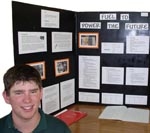
The search for alternative fuels featured in the winning entries at the NIWA Science & Technology Fairs in both Auckland and Nelson, held in October.
Charlotte Taylor of St Cuthbert’s College, Auckland, started with an interest in the Bermuda Triangle. According to the “ocean flatulence theory”, methane hydrate – a gas frozen in deposits under the ocean – sometimes escapes, dramatically reducing the density of the water as it bubbles to the surface. This could cause boats to sink unexpectedly.
Methane hydrate could also be a valuable fuel source if it were successfully harvested. Charlotte worked with dry ice (which has similar properties but is safer and readily available) to design and develop a way to collect the gas. The judges gave her top prize for originality, a very strong scientific and technological base, the holistic nature of the project, and depth of knowledge.
In Nelson, the NIWA First Overall Award and the John Crass Trophy for Best Investigative Science went to Jonathan Nistor of Waimea College for “Fuel to Power the Future”, looking at the most efficient way to produce hydrogen as fuel.
Just over 350 students from 14 schools entered the Auckland fair this year. Nelson’s fair, by contrast, was much smaller because every second year entries are restricted to senior secondary school students. Planning has already begun for next year, which will be a full fair, open to all schools in the region.
NIWA hosts meeting of infrared experts from NDSC

Stephen Wood, from NIWA at Lauder, hosted a meeting of the Infrared Working Group of the NDSC (Network for the Detection of Stratospheric Change) in Queenstown in November. The NDSC is an international network for the measurement of atmospheric trace gases, and this working group concentrates on the measurements made at infrared wavelengths with Fourier transform spectrometers.
Twenty-seven scientists from England, Belgium, Germany, USA, Canada, Japan, and Australia joined six scientists, technicians, and students from New Zealand to discuss matters relating to the network. Three days of meetings in Queenstown were capped by a field trip to Lauder to look at the two infrared instruments NIWA operates there. Topics for discussion included:
- reports from the various sites in the network;
- new developments in extending the scope of the measurements to include gases in the lower atmosphere (the troposphere), especially greenhouse gases such as carbon dioxide;
- techniques for the validation of new satellite measurements using the ground-based measurements; and
- ways of maintaining calibration and consistency across the network.
During the meeting, NIWA staff measured the characteristics of some small calibration cells containing minute amounts of hydrogen bromide (HBr) that were made three years ago and distributed around the network for monitoring the performance of individual instruments.
The field trip on the last day was of interest because Lauder maintains two types of measurements. We measure gases in the mid-infrared (wavelengths from 2 to 14 microns) that are the “traditional” infrared contribution to the NDSC. We are also a test site for near-infrared measurements (wavelengths from 0.7 to 2 microns) that have a new application in the high-precision monitoring of greenhouse gases such as carbon dioxide and methane. The lessons learned at Lauder in adapting and sharing instruments between these two applications will be applied at other sites around the world.
For more information, contact: Stephen Wood, NIWA, Private Bag 50061, Omakau, Central Otago (ph +64 3 440 0426, [email protected])
Winston Churchill Fellowship
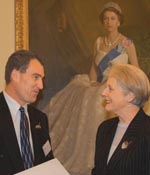
In September, NIWA scientist Andrew Jeffs received a Winston Churchill Fellowship award from Governor General Dame Silvia Cartwright for his investigations of the growth of the aquaculture industry in Australasia. The Winston Churchill awards support individuals to investigate issues that affect the country.
Andrew's study found that for the past 30 years the aquaculture industries in both Australia and New Zealand had grown very quickly, in line with the rapid growth of aquaculture worldwide. He noted differences in aquaculture in the two countries in legislation, diversification, public perception, and strategic focus.
For further information on his study, contact: Andrew Jeffs, NIWA, PO Box 109 695, Newmarket, Auckland ([email protected])
End of a trap
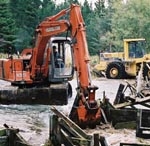
The Glenariffe salmon trap was removed and buried in March 2004. This large wooden structure, which straddled the Glenariffe stream in the Upper Rakaia River catchment, first operated in 1965.
For 38 years it was the scene of a wealth of scientific studies which have given us an important understanding of the biology of chinook salmon. In particular, the trap has provided an extremely valuable long-term dataset on annual variability in numbers of spawning salmon returning to the site each year. Scientific studies using these data have determined the best time and size to release juvenile smolts, and shown what factors in the Rakaia River and the ocean appear to be influencing the size of salmon runs.
With the completion of the research projects the trap’s days were numbered, and dismantling the trap became an exercise in stream restoration.
For more information, contact: Nelson Boustead or Selwyn Hawke, NIWA, PO Box 8602, Christchurch (ph 03 348 8987, [email protected])
New quick guides simplify identification of freshwater flora and fauna
Accurate species identification is the cornerstone of the biological sciences, yet the task can be daunting even for experienced researchers. NIWA has recently completed identification guides for a range of freshwater biota (plants, algae, fish, and invertebrates) which will provide freshwater scientists around the country with the means to make quick and accurate species identifications
The new guides cover native fish species (galaxiids and bullies), aquatic plants (including introduced pest species and threatened natives), various algal groups (including diatoms, blue-greens, reds, and greens), and oligochaete worms. We determined the priority groups of organisms to be covered in the new guides by surveying the needs of key end-users, such as regional council biologists.
Development of the guides has been funded through the Terrestrial and Freshwater Biodiversity Information System (TFBIS) programme, which is administered by Department of Conservation. The work has also relied heavily on research in our FRST-funded “Biodiversity of New Zealand Aquatic Environments” programme.
The new guides are available as free downloadable files from the National Centre for Biodiversity & Biosecurity.
Focus on corallines
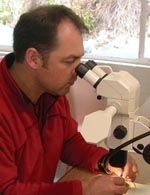
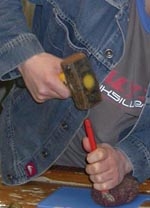
Crustose or non-geniculate coralline algae (NCA) are abundant throughout the New Zealand region, from the intertidal zone to the subtidal zone, sometimes to depths of 200 m. Until recently the New Zealand species have been poorly known. These red algae play a critical role in the construction and ecology of coralline reefs, and are a preferred substrate for the settlement of paua and other invertebrate larvae. Rhodoliths (unattached, free-living corallines) are important refuge and nursery sites for fish and invertebrate species.
In September we ran an NCA identification workshop at the University of Canterbury’s Edward Percival Field Station in Kaikoura. The workshop was organised as part of an MFish-funded project on NCA biodiversity.
The purpose of the workshop was to train people to identify NCA. It incorporated presentations about corallines (what they are, what they look like, how to collect them), and focused on identifying the common species found in central New Zealand, using reference materials and methods developed during the NCA project.
NIWA’s coralline team (Tracy Farr, Kate Neill, and Wendy Nelson) ran the workshop, along with Dr Bill Woelkerling and Dr Adele Harvey, who are experts on the NCA of Australia and colleagues in the MFish research project. The workshop was aimed at participants from varied backgrounds who would benefit from gaining skills in identifying crustose coralline algae. They included staff from NIWA, Department of Conservation, universities, iwi, and other interested parties.
Participants worked with the draft version of a guide which, as well as detailing simple identification methods, is intended as a reference and field manual. Participants’ feedback and experiences test-driving the guide have provided invaluable suggestions for improvements and ways to make it more user-friendly. The final version of the guide will be available early in 2005.
For further information about the workshop or the new guide, contact: Wendy Nelson, NIWA, Private Bag 14901, Wellington (ph +64 7 386 0300, fax +64 7 386 2153, [email protected])
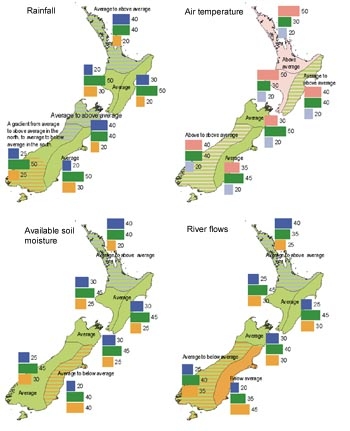
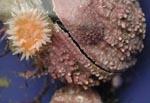
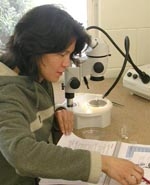

Recent publications by NIWA staff
Lists of the most recent publications by NIWA staff are compiled each month and posted on the NIWA website. These lists include papers published in refereed journals, proceedings, books and book chpters, as well as conference and seminar presentations and popular articles.
